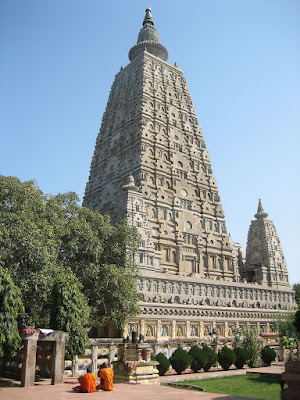Okay, so my favorite character class to play in RPGs (well, D&D style fantasy games) is the cleric. In fact, my first ever RPG character was a cleric. All I really remember of that game is a raft trip that the party barely survived, which was awesome.
The early editions of D&D (and Chivalry & Sorcery) based their clerics heavily on ideas derived from Christianity, both biblical references (such as the spell "Sticks to Snakes") and the church in medieval times. Later more non-christian, polytheistic elements, both historical and fictional, were added to RPG gaming. But the people making the games and playing them were overwhelmingly from Western civilization countries which are basically culturally monotheistic.
This monotheistic, christian cultural background leads game developers, GMs, and players to handle fantasy polytheistic clerics, religions, and temples like monotheistic, semi-christian ones. For instance, I was listening to an RPG podcast this week and one of the poddies mentioned making a fighter who would follow a particular deity. That's not generally how polytheistic cultures do things. In most RPGs the various deities in a fantasy pantheon are typically treated like individual monotheistic faiths. Even the layouts of temples are frequently very much like a christian church, with rows of pews, a lectern for sermons, an altar at the far end, and even stained glass windows.
As someone who likes studying history and world cultures, I find this failure to grasp the basics disappointing and annoying. I can forgive the early authors of the role-playing hobby a certain narrowness of vision. The whole concept was a work in progress. Today, however, the Internet puts the universe at one's fingertips.
So what are these games missing? First off, polytheism features pantheons of multiple deities, with each major cultural region having its own. For instance, during the Roman Empire there was the Greco-Roman pantheon (Zeus, Athena, etc.), the Egyptian pantheon (Hathor, Horus, etc.), the Celtic pantheon, and so on. The people living in a particular area worship their cultural pantheon in their particular way. All their temples are built in the same style, according to that culture's local architectural traditions. Polytheistic cultures are often said to be accepting of foreign deities, and this is true to a point. Often what happens is they find a deity amidst their pantheon which corresponds to the foreign god and accept it on that basis.
People in a polytheistic culture are not limited to selecting only one deity from their pantheon to follow, forsaking all others. Typically, they worship all of them--as needed. Planning a sea voyage? Then prayers to Neptune are in order. Heading off to war? A proper sacrifice to Mars is a good idea. The situation with priests may be different, depending on the culture. In some, priests are actually dedicated to just one deity. In others, they are more general holy persons who may or may not serve at a particular location. However, it is possibly for individuals to have a favorite deity for some reason, or even for a particular city to have a favored deity. Corinth was associated with the goddess Aphrodite, for instance. But that did not require rejection of or hostility towards any of the other deities.
Temples where not usually laid out like Christian churches. The typical temple would be centered around a main idol to one deity, or maybe three. The main idol would be in a central chamber facing the main (or only) entrance. This chamber might be very high in order to accommodate as large and imposing an idol as possible. The facing of the idol/entrance was usually based on a theological or cosmological concept, such as facing east towards the rising sun. There could be smaller idols to other minor deities to the sides. In front of the main room would be either an antechamber, enclosed forecourt, or open plaza; in the case of a very small temple in a rural area there might be just a simple cleared area of ground out in front. Pews or seating were not typical. Priestly staff and worshipers would stand, kneel, or sit on either the bare floor (stone, wood, or packed earth) or perhaps on mats or rugs.
Beyond the basic layout of main chamber and a room or open area in front many variations and expansions were possible based on the cultural architectural norms, site topology, and need for other buildings such as dormitories, libraries, schools, courtyards, etc.
So here are some example images I grabbed from the Internet which illustrate typical temple layouts:
Also, here are some Wikipedia articles with examples of real temple styles, showing the rich variety of architectural forms used for worship:
https://en.wikipedia.org/wiki/Hindu_temple_architecture
https://en.wikipedia.org/wiki/Khajuraho_Group_of_Monuments
https://en.wikipedia.org/wiki/Ancient_Greek_temple
https://en.wikipedia.org/wiki/Temple_of_Confucius
https://en.wikipedia.org/wiki/Shinto_shrine
https://en.wikipedia.org/wiki/Thai_temple_art_and_architecture
https://en.wikipedia.org/wiki/Pagoda





No comments:
Post a Comment